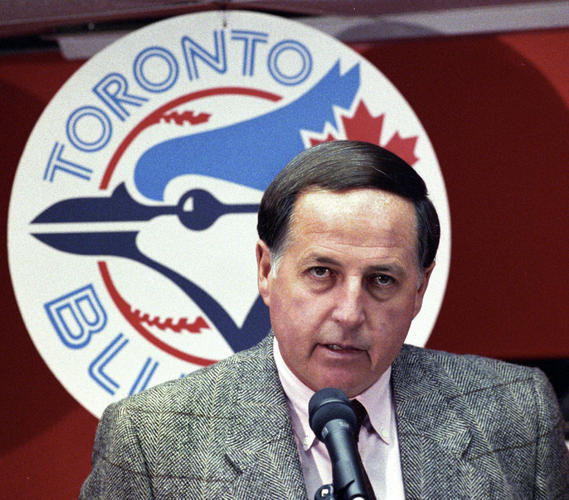
A look into the team’s ascension to greatness and its heydays
Part 3: Major surgery on the roster for the perennial winner
After the 86-76 Toronto Blue Jays finished the 1990 season in second place (two games behind the division winning Boston Red Sox), GM Pat Gillick pulled off arguably the most significant trade in the history of the franchise. It would soon pay huge dividends to the team. On 5 December 1990, while at the Baseball Winter Meetings in Chicago, Gillick traded Tony Fernández and Fred McGriff, two of the club’s cornerstones, to the San Diego Padres for second baseman Roberto Alomar and right fielder Joe Carter.
While the trade came as a shock for many Toronto fans, the deal was sensible. From a roster construction point of view, it appeared as through the Blue Jays were good enough to be a regular playoff contender but not talented enough to win it all. Therefore, in order to take the club to the next level, Gillick had to make the difficult decision of cutting ties to a number of the remaining big-time contributors that had been leading the team since the mid-1980s so that he could change the culture of the franchise. From an asset management perspective, there were rumours that Fernández had threatened to retire repeatedly, so it made sense to trade him and net players in return. From a line-up perspective, as solid as both McGriff and John Olerud were as players, especially after the latter came into his own, there was nevertheless a redundancy in retaining both of them since they both batted left and played first base. Also, seeing that both McGriff and Olerud were still young at the time, it made little sense to shift one of them to the designated hitter spot, which is a position that is more suitable for strong hitters who are in the latter stages of their careers, as they do not have to worry about defensive responsibilities. By swapping McGriff for Carter, who was a right-handed power bat, there was more balance to the line-up, not to mention that Carter could bring home run power and a strong throwing arm back to the right field position that had been missing since the departure of Jesse Barfield. Another reason why “the trade” made sense was because the promising Olerud, who was a terrific contact hitter and strong defender at first base, could simply replace McGriff as our full-time regular first baseman. Finally, second baseman Manuel (Manny) Lee could shift over to play shortstop in place of Fernández given that Lee was a natural Shortstop.
“While the trade came as a shock for many Toronto fans, the deal was sensible.”
The Fernández and McGriff for Alomar and Carter trade set the nucleolus for the club’s championship runs in the early 1990s. Of course, other moves were made to make the road to the World Series a reality, including certain major trades and free agent signings. Prior to the 1991 season, Gillick traded for gold-glove center fielder Devon “Devo” White on 4 December 1990 who came from the California Angels to Toronto along with Willie Fraser and Marcus Moore in exchange for Junior Felix, Luis Sojo, and a player to be named later. The acquisition of White was significant because he provided the kind of speed and defence that had been absent since Mookie Wilson (who replaced Lloyd Moseby as the regular center fielder from 1989-1991) left the Blue Jays. The mid-season pickup of Candy Maldonado from the Milwaukee Brewers on 14 August 1991 for Bob Wishnevski and a player to be named later (William Suero) stabilized the left field position and in the process created an everyday outfield of Maldonado, White, and Carter that Toronto fans had not seen since the days of Bell, Moseby, and Barfield.
After the 91-71 Blue Jays were eliminated by the highly experienced and savvy Minnesota Twins in the 1991 American League Championship, Gillick was determined to do whatever was necessary to bring a World Series Championship to Toronto. The players in the Blue Jays’ clubhouse were equally confident as they genuinely felt that the team was only one or two missing pieces away from winning it all. Several of them actually commented that for the 1992 season, the minimum acceptable level for the team would be a World Series appearance. Even though long-time ace Dave Stieb’s effective days came to an end in the 1991 season, the club received a shot in the arm when Juan Guzman, Todd Stottlemyre, and David Wells all entrenched themselves in the starting rotation, which more than offset the loss of Stieb. Gillick was not about to take any chances though as he felt that he needed to acquire a top dog to lead the starting rotation and increase the offensive output at the designated hitter position since the once steady Rance Mulliniks was near the end of his career. The Toronto GM therefore dipped into the unrestricted free agency pool by signing money pitcher Jack Morris (the pitcher with the most wins in the 1980s) on 18 December 1991 to serve as staff ace and slugger Dave Winfield to be the Blue Jays’ full-time Designated Hitter on 19 December 1991.
Why were the signings of Morris and Winfield such game changers? Also, what are reasons behind Toronto’s transformation from being the least-preferred destination in the late-1970s/early-1980s to the most-desired landing site during the early-1990s for top unrestricted free agents? To find out, be sure to tune in to Part 4 of my article.
